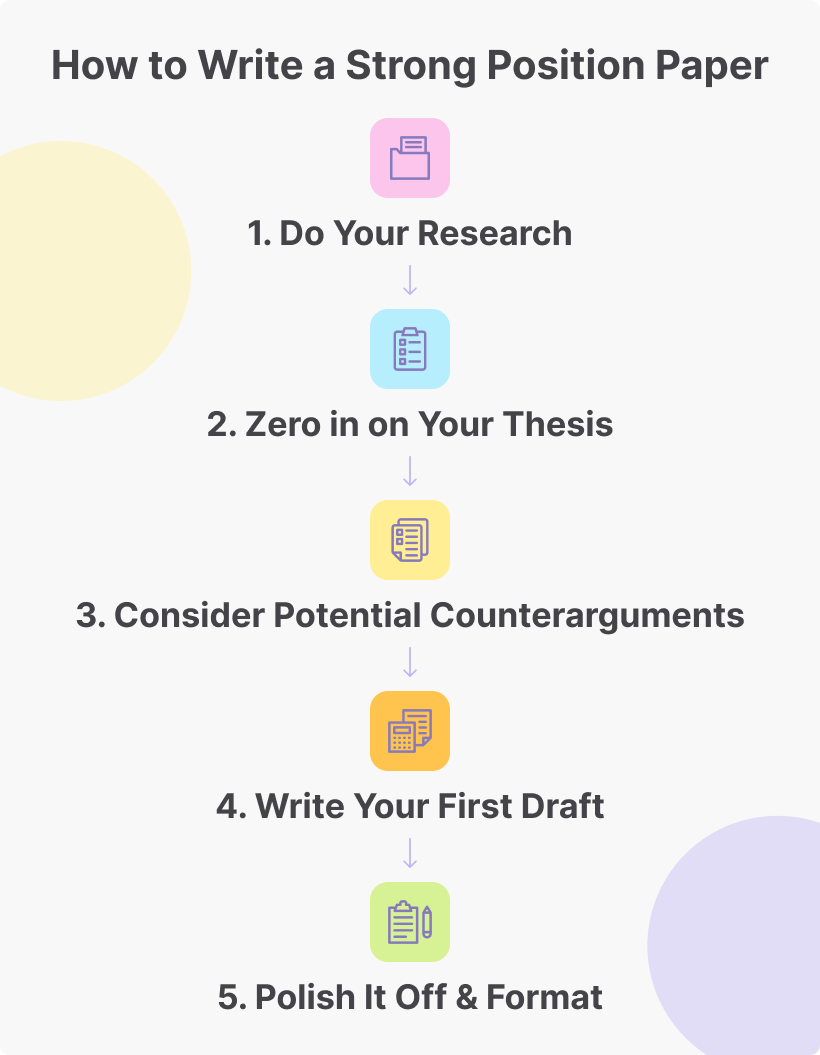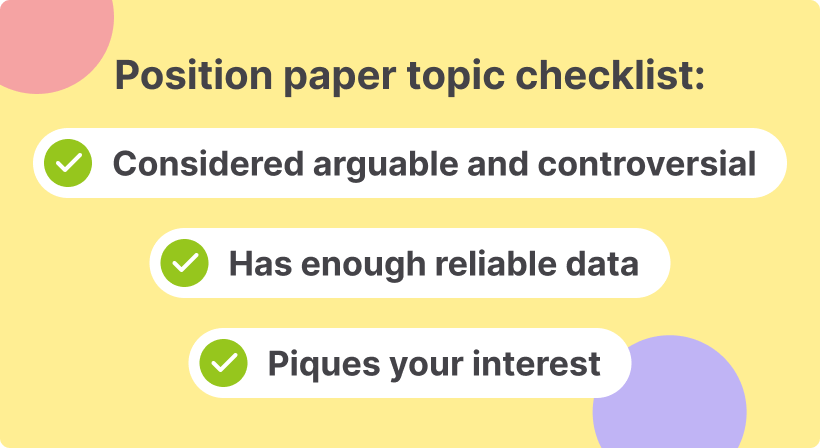
How to write
How to Write a Position Paper: Your Ultimate Guide
Author:
Samantha Williams
Sep 15, 2023
10 min
Table of contents
- How to Write a Position Paper: Your Ultimate Guide
- But First, What Is a Position Paper?
- How to Write a Strong Position Paper in 5 Steps
- What’s the Standard Position Paper Outline?
- Position Paper Topics to Inspire You
- Tips for Writing a Position Paper that Gets You an A
- How to Write a Model UN Position Paper
How to Write a Position Paper: Your Ultimate Guide
Whether you major in economics, law, or psychology, you may be asked to describe your stance on a specific subject in a position paper. This assignment teaches you a valuable skill: clearly expressing and backing up your position on a matter.
But if it’s your first time writing one, or if you’ve been struggling with it, you’ve come to the right place! Having handled hundreds of write a paper for me requests, our expert writers weighed in on how to craft a strong position paper.
Here’s everything students like you need to know about it, from the position statement definition to expert tips and more.
But First, What Is a Position Paper?
Let’s kick things off by breaking down the position paper meaning. Position paper is a piece of writing that describes the author’s stance on a specific topic and why the author is taking it. It can be published to clarify and justify an individual’s or organization’s standpoint on a matter.
While it’s a common assignment for students, the position paper format is also widely used in professional settings in the following fields:
- Law;
- Healthcare;
- Government and policymaking;
- Education;
- Scientific research;
- Economics and finance.
You may also be tasked with writing a position paper if you participate in a Model UN conference.
How to Write a Strong Position Paper in 5 Steps
To support your position statement, you first need to do your research and gather statistics, facts, and other evidence that backs up your position. But that’s only half the journey! You need to go the whole nine yards and put in the work to craft a strong position paper.
Here’s our guide on how to write a position statement in five simple steps, put together by our experts.

1. Do Your Research
Before you think about how to start a position paper, you need to do your research on the topic from multiple angles. Make sure you consider all possible stances and evidence that can be used to support each of them.
In your research process, rely on credible sources: researchers, NGOs, governmental bodies, international organizations, etc. Avoid opinionated sources and those that have conflicts of interest.
While you’re doing your research, take notes of evidence and all sides’ arguments in whichever way you prefer. You’ll then use those notes to organize your arguments, evidence, and other data in an outline.
2. Zero in on Your Thesis
To settle on your own stance, consider the pros and cons of every side of the argument. While your own views matter, they can’t be the only reason you pick this or that standpoint – there also should be enough evidence to support it.
Remember that you’ll also need evidence to respond to potential counterarguments.
Once you settle on your thesis, jot it down, along with two or more arguments in its support and 2-3 supporting reasons.
3. Consider Potential Counterarguments
Writing a position statement doesn’t mean simply breaking down your own position on the matter. You should also address any challenges that your opponents may bring forth.
In other words, you should convince your readers your stance is the logical or optimal one by clearly stating why it should prevail over others.
To be well-armed in defending your thesis, add counterarguments and their supporting evidence to the outline. You can also add a brief description of other stances and their main reasoning to the introduction.
4. Write Your First Draft
With the understanding whats a position paper and an outline in front of you, you can now get to writing. If you’ve done your due diligence in the previous three steps, writing itself should be relatively easy. All you have to do is expand the outline you’ve put together.
(If you struggle with the outline, we’ll break down how to make one for a position paper below.)
While you may be tempted to worry about whether to use the position paper APA format or the MLA one at this stage, don’t. Leave formatting for when you edit the draft. The same goes for creating the title and references page.
5. Polish It Off & Format
No draft is perfect, but that’s why it’s called a draft! So, make sure you plan for enough time to polish it off. Ideally, you should let it sit – even if for an hour or two – before you edit it so that you have a fresh outlook.
During editing, make sure you:
- Proofread your draft (you can use tools like Grammarly to speed this up);
- Edit your text for clarity and conciseness;
- Meet the recommended length requirement.
As for the formatting, it’s best to save it for last. During editing, you may add or remove citations, for example. If you formatted all the references before, removing one source will change the corresponding number for certain citations – fixing which is time-consuming.
What’s the Standard Position Paper Outline?
Organizing your text in a logical flow of thought is a vital part of how to write position paper. The position paper structure consists of:
- Introduction: pique your readers’ interest with a hook, describe existing stances, and introduce your thesis and its main supporting arguments.
- Main body: describe your supporting arguments (one per paragraph) and debunk their respective counterarguments.
- Conclusion: reiterate your thesis and sum up arguments in its support.
Let’s take a closer look at how to write every part of the position paper.
Introduction
When you put together your position essay outline, consider the introduction as the opening for your paper. That’s why it should start with a hook: a sentence that captures the reader’s attention and makes them invested in the rest of your paper.
Hook example:
It’s impossible to tell precisely how many children are homeschooled in the United States– 11 states don’t require parents to inform anyone before they take their children out of school.
After the hook, introduce the reader to the topic and describe its background and context. Then, describe the prevailing stances on the matter and clearly state your thesis. You can also add the main supporting argument for it.
Thesis statement example:
While proponents of lax regulations around homeschooling maintain tighter regulation would infringe on the personal liberties of parents, introducing security measures on the federal level would prevent child abuse.
Main Body
Every main body paragraph should be dedicated to one argument in support of your thesis – not more, not less. But whats a position statement body paragraph outline?
Here’s a basic outline you can use to structure the paragraphs:
- Topic sentence – it should give a clear idea of what your argument is;
- Evidence – data and facts from credible sources that support your argument (2-3 pieces of evidence suffice);
- Counterargument – how your opponents may rebut the argument;
- Counterevidence – why your opponent’s counterargument doesn’t hold up.
Having a hard time crafting an essay?
Let our highly skilled experts handle your daunting tasks and have a well-deserved break. Top-tier quality guaranteed.
Ace my paper
Conclusion
What is a position essay conclusion? In a nutshell, this is where you reiterate your thesis and sum up all the arguments in its favor.
You don’t have to copy and paste your thesis from the introduction here; it’s best to paraphrase it. As for the arguments, condense them into a simple list of reasons to support your thesis.
How long should your conclusion be? One paragraph typically suffices. Keep in mind that you can’t give any new information in the conclusion or cite new sources – you can only summarize what you’ve written in the main body.
Position Paper Topics to Inspire You
Good position paper topics are arguable – i.e., they don’t revolve around black-and-white issues where you can’t exactly argue against a specific position.
If you’re not given a clear topic for your position paper, it may be difficult to come up with position paper ideas from scratch. To help you out, we’ve put together these 11 topics for position paper you may use to find inspiration:
- How can homeschooling policy be improved to protect children?
- Are the effects of social media use overall beneficial or harmful to society?
- Should prisoners receive free healthcare?
- Is it ethical to use generative AI tools in professional communications (e.g., emails)?
- What is the most efficient and ethical way to prevent illegal immigration?
- Should solitary confinement remain a common practice in the prison system?
- How should the government encourage individual behaviors beneficial for sustainable development?
- What is the one policy that would be the most efficient in reducing carbon emissions in a given country?
- What is causing the rise of right-wing nationalism across the world?
- Should museums in former colonialist powers return stolen exhibits to former colonies?
- Are tech monopolies beneficial for driving technological innovation?

Tips for Writing a Position Paper that Gets You an A
Writing a position paper isn’t that difficult. But writing a convincing and strong one is a different story. That’s why so many students google write my college paper for me and turn to us for guidance.
Here are our experts’ six tips on how to write a good position paper:
- Read your assignment or prompt carefully. Make sure you understand what’s expected of you perfectly. Pay extra attention to the grading section of the assignment.
- Know your audience. If your audience is well-versed in the topic, you can use professional jargon in your text. And if they’re not, you’ll have to take time to explain certain terms and concepts.
- Embrace gray-area topics. Black-and-white issues don’t make for compelling position paper topics – no one would disagree that child abuse should be stopped, for example. So, choose a topic that sparks debate.
- Be concise. Strive to make every word count. Avoid filler phrases, and don’t inflate the word count just for the sake of hitting the required paper length.
- Fact-check your sources. Even if one study supports your argument, it doesn’t make it automatically reliable. Check the sample size and structure and whether the study was peer-reviewed before relying on it. Consider potential conflicts of interest, too.
- Don’t get subjective. While your opinion does matter when you select your stance, your thesis can’t be based simply on your feelings or preferences. It has to be backed by tangible evidence from reliable sources.
How to Write a Model UN Position Paper
If you’ve stumbled upon this blog post because you’re participating in the Model UN, a position paper bears a slightly different meaning. While it’s still meant to clarify your stance on a topic, you will be arguing from the point of view of your nation-state.
So, what is a position paper in MUN? A MUN position paper is an essay that details your nation-state’s policy on the topic of the conference. It should not just state facts but also set the foundation for proposals.
Keep in mind that you will read your position paper during the opening ceremony of the conference. So, it has to be more than just well-written – it should also make for an engaging speech. For this reason, MUN position papers are also shorter (1-2 pages maximum).
Here’s our short guide on how to write a MUN position paper, from the paper format to the standard structure.
What’s the MUN Position Paper Format?
The National Model United Nations Association has issued the following guidelines on formatting position papers:
- Length: up to two pages;
- Margins: 1”;
- Font: Arial, 10pt;
- Alignment: justified;
- Heading: centered, written in the format “Delegation from [Member State]”;
- Don’t include citations, national symbols, and your university’s or sponsoring organization’s name.
However, if you are given different requirements by organizers, stick to them.

How to Create a Model UN Position Paper Outline
A strong MUN position paper outline should consist of:
- A brief overview of the state’s history regarding the topic and committees
- A breakdown of how the topic impacts the state;
- The state’s policies and actions taken on the subject and their reasoning, with statistics and other evidence to back them up;
- The state’s proposals for addressing the discussed issue;
- The state’s goals in each committee.
Premium academic assistance from seasoned pros
Hire a writerFAQ
Also known as a position paper, a position statement is a paper that sums up the individual’s or organization’s stance on a specific topic and supports it with evidence.
A position paper is meant to clarify your personal or the organization’s stance on a specific topic and back it up with evidence that supports it. It can also be used to persuade readers to adopt the stance.
A good position paper topic is controversial and sparks debate among the audience. It doesn’t have a clear-cut answer and has two or more sides.
A typical position paper is around 1,000-1,500 words (2-4 pages) long. However, if your assignment specifies a recommended length, we advise you to stick to it.
A position paper consists of three main parts: introduction (topic and thesis), main body (one paragraph per argument in support of the thesis), and conclusion (summary of the arguments).


